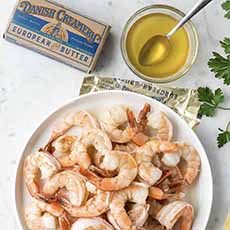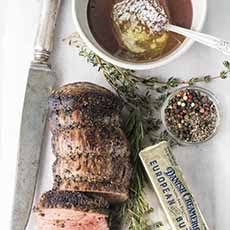TOP PICK OF THE WEEK: Danish Creamery European Style Butter
|
Here’s some news for people who love their butter and products made with it: Not all butter is created equal. In addition to the base milk (organic versus conventional, the breed of cow, grass fed [free range]), different butters are churned to have different butterfat contents. In the U.S., products sold as “butter” must contain at least 80% butterfat (milk fat), and has 15% butter. Most American butters contain slightly more than that, averaging around 81% butterfat. European butters generally have a higher ratio: a minimum of 82%, with many at 83% and one up to 86%: the small-batch cultured butter from Vermont Butter and Cheese Creamery (which is a spreading butter, not a cooking butter). For a long time, professional bakers were able to purchase 83% butters on a wholesale level. Why care? The higher butterfat content, the richer the flavor and the creamier the texture. Higher butterfat means less water. Lower the moisture content yields flakier pastries, cookies that crisp more evenly and cakes that rise higher. When the American brand* Plugrá, an 82% butter, was made available to consumers in 2001, it set off a buying frenzy among serious home bakers. The brand achieved such growth that, in Land O’Lakes and other producers subsequently introduced European-style butters, and foodies-in-the-know sought out brands from small artisan producers. In 1895, Danish immigrant families in the fertile hills of Fresno, California, formed a dairy cooperative modeled after those they’d had in Denmark. They created Old World-quality butter made from humanely-raised cows that munch grass on the pasture of family farms. This is the beginning of great butter. For generations, Danish Creamery butter has been available across the Western U.S., used by millions for cooking and baking and spreading on bread. The company has now launched the crème de la crème (pun intended), European Style Butter: a velvety, 85% butter that will make your taste buds take notice. The cream comes from the same pasture-raised cows, but with 85% butter fat for a richer taste and texture. Go ahead, the company says: “Bake your fluffiest biscuits, your flakiest pie crusts, your butteriest cakes and pastries with this, our creamiest butter yet.” We have, and it’s great! For baking we use the Unsalted Butter, but there’s also Salted Butter for those who like a hint of salt at the table. And you can find it at Wal-Marts nationwide. Get some for your holiday baking. If you don’t bake, get some for cooking and toast. If your friends cook or bake, get them some. For enlightenment and for fun, gather up some different brands or butter—perhaps 82% Plugra and a standard supermarket brand—and do a blind taste test! This is an especially fun tasting when you first taste a pat blind, then follow up with biscuits, muffins and scones. |
|
|
|
|
||







